1 Current State of Space Operations (Pritchard)
Student Objectives
- Introduce and integrate fundamental space operations terminology
- Identify the history and historical relationships of space operations
- Distinguish between space domain, space technologies, and space operations
- Understand technological development priorities
Introduction
To understand Space Operations, we first have to understand the broader concept of ‘operations’ as it relates to a domain and the technologies that operate within that domain. In other words, let us have a non-space conversation on just the following: domains, operations, and technologies. Generically speaking, what are these three concepts? And how are they interrelated? Foremost, domains, operations, and technologies are highly interconnected. Domains incorporate the objects, concepts, and rules that define a particular area of knowledge or activity. Operations are the basic actions that can be performed on those objects, concepts, and rules. Technologies are the means by which we perform those operations. (See Figure 1-1)
Figure 1-1 Domains, Operations, and Technologies
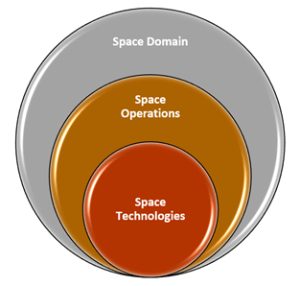
Source: (Pritchard M. ) (Operations, 2022)
Now that we have our taxonomic relationships worked out, we can now overlay the concept of Space into this conversation. A space domain is an area of knowledge or activity that deals with objects, concepts, and space-related rules. A space operation is an action that can be performed on objects, concepts, and rules related to Space. Space technologies are the means by which we perform space operations. Okay, so maybe we need to add more definitions to this exercise. Space technologies allow humans to accomplish actions, which are operations within the environmental domain we call outer Space. These actions – these space operations – exemplify our ability to study celestial objects such as planets, pulsars, galaxies, and even black holes. They are further exemplified by our ability to traverse and explore our solar system. These specialized activities, which are classified as space operations within the harsh environmental space domain, are only possible through the design and employment of space technologies. So, to better understand Space Operations, let us take a historical journey through a) the Space Domain and b) Space Technologies. First up, is the Space Domain.
Space Domain
When did people first see Space as a working domain? Well, you would be surprised at how far back we can go. The evolvement of Space as a “working domain” can be categorized into a kind of product lifecycle: ideation, research, development, and operations. In total, these phases cover thousands of years. Humans have been fascinated by the waxing and waning of heavenly bodies for a long time. Many scholars believe that the development of the Aurignacian Lunar Calendar, nearly 32,000 years ago, is the earliest data point we have where there is demonstrable evidence of human celestial awareness (Peregrine, 2001) (Gheorghiu, 2013) (Soderman, 2021). Small and lightweight, these lunar calendars were simple to transport on long seasonal excursions and extended hunting expeditions (See Figure 1-2, Aurignacian Lunar Calendar). These calendars were often carved into animal bones (or stones). The largest creatures were difficult to hunt, and the codification of celestial phenomena into animal bones gave hunters the power of foresight. They used this antique space information system.[1] To predict the movement of Earth’s Moon. At this point, a clearly documented phase of ideation occurs in human evolvement toward the space domain.
Figure 1-2 Aurignacian Lunar Calendar
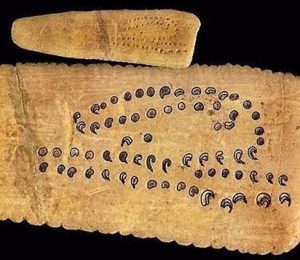
Sources: (NASA, 2022) (Marchant, 2009)
These lunar calendars were not isolated to a few smart human hunters; their usage was found throughout Europe (Gaffney, 2013). Let us jump forward 30,000 years where we find the ideation phase of many cultures ends and the research phase begins. Roughly 3,600 years ago, humans began to develop better celestial tracking mechanisms. Humans started to create various sky mapping tools, such as the Nebra Sky Disc (See Figure 1-3, Nebra Sky Disc). This antique object, which measures around 30 centimeters, has been linked to the Unetice people who lived in a region of Europe. Reconstructed, the dots are believed to be stars, with the cluster standing in for the Pleiades. The huge circle and crescent represent the Sun and Moon.
Figure 1-3 Nebra Sky Disc
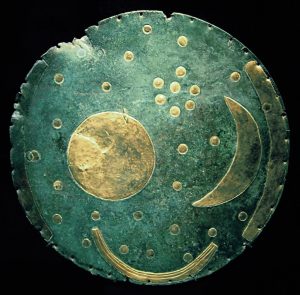
Source: (Google Images, 2018)
Figure 1-4 Recovered Antikythera Mechanism
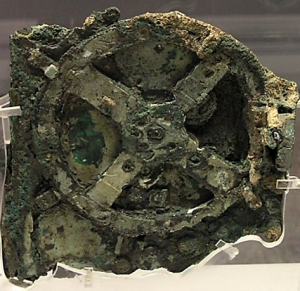
Source: (Wikimedia, 2022)
The research phase of this story moves us forward a few hundred years to the creation of the Antikythera Mechanism (See Figure 1-4, Recovered Antikythera Mechanism). Created by Greek scientists roughly 2200 years ago, the device was used to forecast astronomical phenomena. It is described as the oldest example of an analog computer. A hypothetical schematic of the Antikythera Mechanism was proposed by Freeth and Jones in 2012. Using a stylized clockwork gearing structure, the mechanism showed in reverse engineering that it could forecast the elliptical trajectories of the planets and the retrograde movement of the Moon and Mars (Freeth & & Jones, 2012). The introduction of a pin-and-slot epicyclic mechanism, which is the circumference of a big circle with the Earth at its center, came more than a millennium before the first known clocks recorded in antiquity (Marchant, 2009)
Figure 1-5 Reconstructed Antikythera Mechanism

Source: (Freeth & & Jones, 2012)
This phase of our story would last for nearly 2100 years. This time frame would include the likes of Abd al-Rahman al-Sufi (Azophi), who developed detailed star charts for each of the major constellations in the 10th Century. This would be followed by many great insights developed by Ibn ash-Shatir (planetary motions that were empirically testable, 14th Century), Nicolaus Copernicus (Earth is not the center of the universe, 16th century), Sir Isaac Newton (Law of Universal Gravitation, 18th Century). The research phase largely ended at the beginning of the 20th Century (in 1905) when Special Relativity was first published by Albert Einstein (and General Relativity in 1915). It is during this time that the development phase of our story truly begins. In the early 20th Century, with scientific advances by Konstantin Tsiolkovsky, Robert H. Goddard, and Hermann Oberth (Neufeld, 2012). Initiated within Germany in the 1920s by Fritz von Opel and Max Valier, the first effective large-scale rocket experiments were ultimately performed by Werner von Braun. This is when space technologies finally begin to take shape.
Space Technologies
In October 1957, the Soviet Union sent the Sputnik 1 satellite into Space. This was the first time an artificial satellite was put into Earth’s orbit. The satellite weighed 83 kg (183 lb) and orbited Earth at an altitude of 250 km (160 mi). Broadcasting for the world to hear, Sputnik produced a heartbeat signal at 20 megahertz. However, most people do not realize that Sputnik was, in fact, not the first time we put technology into Space. The first human-made object to ever reach outer Space was achieved by the Germans in 1944 via the Aggregat 4[2] (commonly known as the V-2) rocket development program (See Figure 1-6, V-2 Cutaway Diagram).
Figure 1-6 V-2 Cutaway Diagram
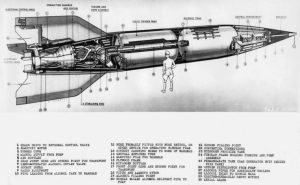
Source: (forbes, 2019)
On June 20, 1944, the Germans performed a test launch with a rocket cryptically named MW 18014 (an A-4 rocket) at the Peenemünde Army Research Center. MW 18014 reached an apogee.[3] of 176 kilometers (109.3 miles…well above the Kármán line[4]). It was the first artificial object to enter Space and the first suborbital flight of a human-made object. While MW 18014 did enter orbit for a short period, it could not maintain orbital velocity and crashed back to Earth. During (and shortly after) the conclusion of World War II, Russia and the United States embarked on an intellectual property acquisition spree. The United States began acquiring a significant amount of science from Germany (nuclear physics and rockets) and Japan (biochemical weapons). After World War II, A-4 rocket hardware was quickly acquired by both Russia and the United States. Using a highly modified A-4 (V-2) rocket, the United States (US) captured the first-ever image of Earth from outer Space from the White Sands Missile Range in New Mexico (Vinogradov, 1968). In 1946, the footage was taken using a 35mm camera placed between the fuel tanks of the V-2 rocket (See Figure 1-7, First Photo of Earth). A single rocket launch from the New Mexican desert ignited the Space Race, the Cold War, and experimental space sciences all at once (Kelvey, 2021).
Figure 1-7 First Photo of Earth
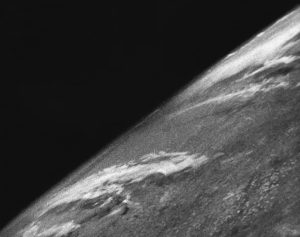
Source: White Sands Missile Range / Applied Physics Laboratory (Pinterest, 1947)
Space technologies made rapid progress over the next two decades. The Soviet probe Luna 2, which made a hard landing on September 14, 1959, was the first spacecraft to make contact with the Moon’s surface. On October 7, 1959, the Soviet (USSR) spacecraft Luna 3 took the first image of the Moon’s far side (see Figure 1-8. Far Side of the Moon). The USSR successfully sent the first human into Space, Vostok 1, in April 1961. Automatic systems managed the whole mission. This was due to uncertainty on how a human may respond to weightlessness among medical personnel and spacecraft engineers. While the USSR was a dominant space engineering power throughout the 1950s and 1960s, the US made progress on human spaceflight via Project Mercury. Project Mercury was the first crewed US space program from 1958 to 1963. It had a round-trip objective; with a safe return, launch a man[5] into Earth orbit. The National Aeronautics and Space Administration (NASA) was formed and took over the program from the US Air Force. Six successful astronaut flights were performed.
Figure 1-8 Far Side of the Moon

Source: Russian Space Agency (rankred, 2020)
NASA’s second human spaceflight initiative was Project Gemini. Gemini, a project between Mercury and Apollo, began in 1961 and ended in 1966. Two astronauts were aboard the Gemini spacecraft (See Figure 1-9. Gemini Capsule Cutaway). In 1965 and 1966, 16 different astronauts and 10 Gemini teams completed low Earth orbit (LEO) flights. Gemini’s goal was to create spaceflight technologies to help Apollo achieve its goal of putting humans on the Moon. Showing mission endurance up to slightly under 14 days, longer than the eight days needed for a round journey to the Moon, enabled the United States to catch up with human spaceflight capabilities that the Soviet Union had attained in the early years of the Space Race. In the race for Space, the US would eventually surpass the USSR. The Apollo 8 crew were the first humans to enter lunar orbit and actually sight the Moon’s far side on December 24, 1968. On July 20, 1969, the US made the first human landing on the Moon. Commander of Apollo 11, Neil Armstrong, was the first person to set foot on the Moon.
Figure 1-9 Gemini Capsule Cutaway
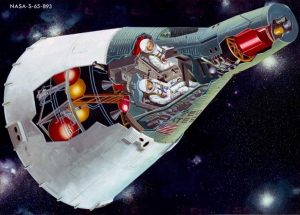
Source: (NASA, 2022)
Since then, space technology has advanced rapidly, enabling humans to land on the Moon and deploy extrasolar spacecraft.[6], explore other planets, and planetoids[7]. The development phase ended, and the operational phase began at 01:29 UTC on December 22, 2015. On flight 20, a Falcon 9 rocket launch became the first successful return (via vertical landing) of an orbital rocket’s first-stage booster. After a five-year program to create a reusable launch system, the first stage made a successful landing. The success of flight 20 was a history-making moment for human spaceflight. It marked a significant milestone toward reusable and modular rocket systems that can significantly reduce the cost of launching payloads into orbit (Figure 1-10, SpaceX Falcon Rocket Program).
Figure 1-10 SpaceX Falcon Rocket Program
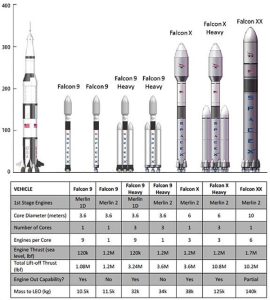
Source: SpaceX Corporation (SpaceX, 2022)
Space technologies span many categories: orbital launch systems, spacecraft, space stations, spaceflight, energy, communications, propulsion, navigation, security, and life-support. With increasing diversity, humans have been expanding their technological footprint; here is a summary snippet of our current technological capabilities:
- Launching and moving space mobility and logistics – Technologies in the space mobility and logistics (SML) area support the transportation of people and supplies into – and across – Space. This can include bringing astronauts to and from the International Space Station or transporting materials to be used in construction projects in Space. However, it also includes two important subcomponents: space accessibility and on-orbit sustainment. Space access includes the launch services to move a spacecraft from Earth to orbit (Operations, 2022). The durability of space operations is reinforced by using ridesharing and alternative launch services and sites. The lifespan of a spacecraft, including maintenance, reconstitution operations, operational deterioration or loss, and end-of-life actions, is included in on-orbit sustainment. These activities are supported by maneuvers referred to as rendezvous and proximity operations (RPO). The United States Government is no longer the dominant leader in this area. Advances in operational SML technologies are largely driven by private corporations (Orozco & & Simpson, 2020).
- Exploring and mapping the solar system with robotic spacecraft – Robotic spacecraft are often used to explore and map the solar system. These missions are planned and executed by teams of scientists and engineers, who use the data gathered by the spacecraft to learn more about the planets and their moons. Robotic missions have also been used to study comets, asteroids, and other small bodies in the solar system. In 2020, 114 launches carried nearly 1,300 satellites into Space. The United Nations Office for Outer Space Affairs (UNOOSA) maintains an online index of objects launched into outer Space (United Nations Office for Outer Space Affairs, 2022). This list contains all objects ever launched into Space (i.e., including non-geocentric[8] Spacecraft). As of July 2022, there are 12,874 spacecraft located within the index. Four are classified as ‘interstellar’ (i.e., the Voyager and Pioneer programs).
- Conducting research on the International Space Station (as well as other governmental and soon-to-be commercial space stations) – The International Space Station (ISS) is a cooperative effort between multiple nations to conduct research in Space. Astronauts from various countries live and work on the station, conducting experiments in various fields. While it is starting to show its age, the space station has been used as a test bed for developing new technologies and has served as a platform for educational outreach programs. The International Space Station and Tiangong Space Station[9] They are the only operational space stations; however, there are plans to build commercially accessible space stations in the future. Private companies would own and operate these stations for research, manufacturing, and other commercial activities. It is difficult to say how soon commercial space stations would be up and running, as this depends on the development of the technology and the availability of funding. However, several companies are working on this technology, and it is possible that we could see commercial space stations in the next few years (Fiorentino, 2022).
- Building and operating telescopes to study the universe – Telescopes are often used to study the universe. They can be used to observe distant galaxies, stars, and other celestial bodies. Telescopes can also study the Sun, Earth’s atmosphere, and other objects in our solar system. The most advanced telescopes in current operation are the Hubble Space Telescope and the James Webb Space Telescope. Launched in 1990, the Hubble Space Telescope has provided some of the most detailed images of the cosmos up until very recently. The James Webb Space Telescope is a space-based telescope that began its first light operations in June 2022. Employing a liquid nitrogen-chilled beryllium mirror, it is currently the most powerful telescope ever built, with an ability to see back in time to the very early days of the universe.
- Searching for space mining candidates – While space mining is still ways away, searching for resources on other planets is currently occurring. If we can establish a permanent human presence on another planet, then we will need the ability to mine that planet for resources such as water, minerals, and energy. This would require developing new technologies to extract and process these materials. Humans have already discovered many ideal space mining candidates. For example, the large asteroid Ceres is a good space mining candidate; it is an asteroid that contains water and other minerals. It is also relatively close to Earth, which makes it easier to reach with current technologies (Ermakov, 2017). Other good candidates for space mining include the asteroids Vesta and Psyche, as well as the planet Mars (Thomas & Makowski, 2011). These bodies all contain water and other minerals that humans could use. Additionally, the complex moon systems on Jupiter and Saturn make excellent space mining candidates. For example, with an abundance of hydrocarbons, the Saturnian Moon Titan makes for a great forward operating fuel depot of the future.
Of course, there is a close relationship between space technologies and space operations. Space technologies enable space operations and space activities, while space operations use space technologies. According to the North Atlantic Treaty Organization (NATO), Space was declared an operational domain in November 2019 (Sultan, 2022). While this designation may have a militaristic focus, it extends well into the economic aspects of the domain as well. Morgan Stanley estimates that the global space industry may surge to over $1 trillion by 2040 (Stanley, 2022).
Figure 1-11 Future Growth of the Space Economy
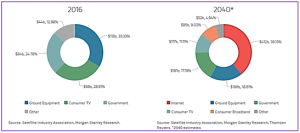
Source: Morgan Stanley (Stanley, 2022)
Figure 1-12 Space, From Ideation to Operation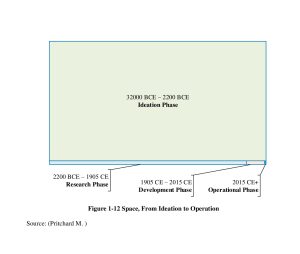
Source: (Pritchard M. )
So, there you have it, from our early ideation roots 34,000 years ago to the present day, we have come a long way (See Figure 1-12, Space: From Ideation to Operation). We have only just begun the operational phase of our journey. The pace of technological development in this domain is running at an exponential rate, and the rate of progress is increasing (Berman, 2016). From here, what are the top technological priorities?
Enhancing Space Operations: Top Technological Priorities
Space Domain Awareness
Formerly known as space situational awareness (Erwin, Air Force: SSA is No More; It’s Space Domain Awareness, 2019), Space Domain Awareness (SDA) is focused on tracking objects in Space, identifying them, determining their orbits, comprehending the environment they are working in, and projecting their future positions and any hazards to their operations. Data is used to forecast conjunctions between objects and warn space operators of potentially hazardous close approaches to enable collision avoidance operations. On occasion, it would be necessary to anticipate and respond to meteor storm debris, fragmentation event debris, or other natural events that could impact operations. All space safety and space traffic management operations are predicated on SDA. Space traffic management (STM) is defined as using SDA to accomplish a real-time goal.
It is crucial to thoroughly understand all the satellites’ orbits as space activity rises. Integrating data from more sensors, even those belonging to our allies, is one method to increase tracking capabilities. There are a variety of difficulties involved with incorporating external data, and there is no assurance that having more data would lead to better tracking. Aerospace has assisted government investigations in exploring the implications and advantages of adding satellite tracking information from foreign sensors into US space object catalog upkeep.
Among many other things, SDA accomplishes the following:
- Ability to perform orbital tracking, determination, and flight predictions at scale
- Creating an ongoing orbital space inventory of items manufactured by humans
- Provide multi-modal data for the development of new offensive and defensive capabilities
A complex and crowded space environment results from the ongoing development of new space technologies and spacefaring entities, as well as the existence of dangerous debris. For instance, in 2021, there were approximately 3,372 active satellites in the Earth’s orbit, more than twice the number of satellites in orbit five years ago. The increase in the number of satellites in orbit is due to the expanding importance that space systems play in terrestrial applications, including GPS, meteorology, and telecommunications. Additionally, the number of satellites is growing due to the continual growth in the number of spacefaring nations and the expansion of space commerce. The commander of US Space Command, Gen. James Dickinson, recently called space domain awareness the command’s “No. 1 need.” (Erwin, Space Domain Awareness: A Secret Weapon Against Shadowy Threats in Orbit., 2022).
The development of SDA requires transdisciplinary development programs. For example, mechanical engineering, electrical engineering, or computer science alone cannot achieve SDA. It requires a wide range of applied transdisciplinary program expertise in Machine Learning, Autonomous Systems, Modeling & Simulation, Cyber Human Systems, Cyber-Physical Systems, and Remote Sensing. Each of the areas mentioned earlier leverages a Systems Engineering approach (Aniculaesei, 2018) (Roscoe, 2019); (Tadjdeh, 2018); (Mittal, 2008); (Akkaya, 2016). While the traditional verticals of engineering education (i.e., mechanical, electrical, computer, chemical, industrial, etc..…) are still very important for building specialized vertical expertise within their respective domains, space systems require transdisciplinary systems engineering program skills to be successful (Watson, 2020).
Machine Learning & Autonomous Systems
Autonomous and automated systems incorporate machine learning into the intelligent management and control of complex systems (Nilsson, 1982). Although they may include crew members as part of the operation, autonomous systems are run independently of other management and control systems. Crewed ships, planes, and spacecraft are instances of autonomous systems. Despite having centralized or decentralized management and control, automated systems are not dependent on human operators. The incorporation of system physics highlights an emergent area for autonomous systems research and operations. For example, Physics-Informed Neural Networks (PINN) can dramatically reduce the amount of onboard training data required to perform autonomous shipboard tasks. A physics-informed autonomous systems integration gives an AI a better ability to manage and predict system dynamics ( (Mao, 2020); (Raissi, 2019). PINN seeks to integrate physics-based knowledge in mathematical equations and data-driven AI/ML for complex scientific and engineering problems (See Figure 1-13, Layered Learning Automata).
Figure 1-13 Layered Learning Automata
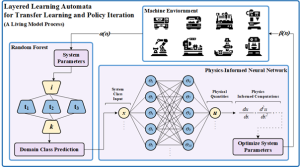
Source: (Pritchard M. )
For AI judgments to be useful concerning system operations, each system function, subsystem, and environment must be as efficient as possible. New AI models that can leverage less training data – while still maintaining precision, recall, and accuracy – will be better positioned to propagate beneficial second-order effects throughout the system (e.g., fewer computational operations per second, increased system responsiveness, less system power required, etc..…).
Figure 1-14 Autonomous System Stack
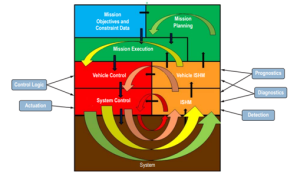
Source: (Watson, 2020)
The difference between automation and autonomy must be understood. Automation is the substitution of mechanical action for human action. This automation may be integrated into the system or used independently in a control center. The relative physical and/or functional separation of decision-making and action or response capacities is referred to as autonomy (e.g., independence of action from a control location). Simply stated, the term automation describes a system process carried out deterministically without human involvement. An automation system cannot extend beyond what it was procedurally developed to do. An autonomous system is an intelligent system that illustrates autonomy when its system process can logically coordinate deterministic, non-deterministic, and stochastic learning functions.
Figure 1-15 Automation versus Autonomy
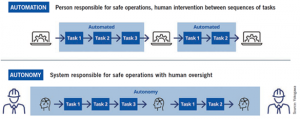
Source: (Fiske, 2021)
Figure 1-16 Automation versus Autonomy
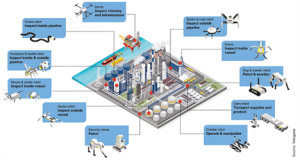
Source: (Fiske, 2021)
According to a joint study conducted by TEConomy Partners LLC, the global market for terrestrial autonomous mobile systems alone is predicted to increase to an estimated $802 billion by 2025–2026. That figure can potentially exceed $1 trillion when Defense, airborne, and autonomous marine systems are included to represent the larger autonomous mobile systems market sector (Tripp, 2021). And just a small portion of that market value will be made up by self-driving automobiles. The scope of autonomous technology, including robotics, artificial intelligence, autonomous cars, and other related sectors, is far greater and broader than that (i.e., space systems operations and exploration).
Cyber-Human Systems
Cyber-Human Systems is a developing transdisciplinary field. Robots, wearable technology, personally integrated sensors & computers, and virtual & augmented reality, are examples of Cyber-Human Systems (Eskins, 2011); (Krugh, 2018). The NSF classifies trends within Cyber-Human Systems (CHS) as taking place across three dimensions: people, computers, and the environment (Foundation, 2022). The human dimension encompasses everything from individuals to society. An important fundamental aspect of CHS is Cybernetics. Cybernetics offers a solution for how a system that controls another system might make up for greater control process mistakes by having a wider range of operational possibilities (Chacón, 2020). The human will take on the function of a higher-level control instance since they are the most adaptable entity in the cyber-physical framework (Barbosa, 2018).
Figure 1-17 Cyber Human Systems
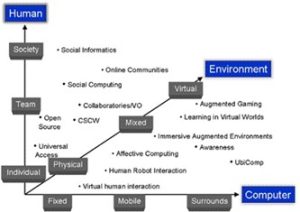
Source: (Foundation, 2022)
The computer dimension includes anything from stationary computing equipment, where a person must be close by, to portable devices (which follow a person wherever they go) to embedded computational systems comprising sensors and visual/auditory devices. Extended reality systems[10] fall in the center of the environmental dimension, which includes discrete physical computational devices and lifelike virtual worlds. Cyber-human systems are a key national security component for the United States; it is part of their “third offset strategy” (Tadjdeh, 2018) (Freedberg Jr, 2014).
Modeling & Simulation
Modeling and simulation (M&S) technologies are used to generate advanced models. Models can be physical, mathematical, or logical representations of systems, entities, phenomena, or processes. In the computer application of modeling and simulation, a mathematical model that comprises important physical model parameters is built on a computer. The mathematical model simulates the physical model and applies the necessary circumstances to set up the desired experiment. A simulation often refers to a computerized version of the model performed over time to analyze the effects of the stated interactions. In general, simulations are developed iteratively. When a sufficient degree of knowledge is achieved, one constructs a model, simulates it, learns from the simulation, revises the model, and repeats the process.
- System:
- A system exists and operates within four dimensions (x, y, z, & t)[11].
- Model:
- A model is a system representation within these four dimensions.
- Simulation:
- A simulation enables human perception, interaction, and analysis of system dimensionality within a complex domain.
The major benefit of high-fidelity modeling and simulation (M&S), supported by high-performance computing, advanced information processing, and artificial intelligence, is the empowerment of a virtual solution space that allows for lower-cost validation of new design concepts. This can provide valuable insights into the relationships between the simulated environment and associated system responses. M&S frameworks also allow for large-scale data analysis and integrated system testing, increasing our ability to find new scientific discoveries. This creates an ability for near real-time numerical experimentation to explore mission trade spaces and evaluate complex systems throughout their lifecycle. Additional M&S opportunities include:
- Reducing program acquisition and systems integration costs through rapid modeling and prototyping of systems
- Immersive visualization systems: 3D immersive, augmented, virtual, and mixed reality technologies for visualization and training
- Predictive threat modeling, agent-based simulations, wargaming & simulation technologies, and multi-domain risk modeling
- Support research, development, and acquisition programs by leveraging advanced simulation technologies to reduce technical risks
- Provide specialized industry training capabilities via advanced simulators and highly immersive scenarios
- Support training and decision-support systems that increase performance and safety while decreasing cost by using modeling and simulation directly in mission systems.
- Increasing mission readiness and outcomes through advanced threat modeling
- Process Modeling and Gaming: Predictive models using machine learning algorithms
- Fosters collaboration among federal agencies, industries, and academia
While Modeling & Simulation activities are traditionally focused on artificially representing the dimensionality of physical systems, new research areas are exploring Real-time Model Projections & Simulation Effects. For example, if you are in a pilot simulation flying across the United States, actual weather patterns would be modeled in real-time within the simulation. In the reverse, simulated models (and digital twins) can be projected over real-world objects to enhance and highlight important physical object features (both externally and internally).
Cyberspace within Space
Cyberspace and extraterrestrial security challenges are merging. Space-based communication and information services are becoming more and more important to the internet. Similar to cars and medical equipment, satellites and other space assets are considered devices on the internet of things since they operate on internet-based networks. Space-related activities are growing and changing due to new government actors, businesses, ambitions, and technologies. However, neither cybersecurity nor space policy is equipped for the difficulties brought about by blending cyber and physical Space, which could raise national security vulnerabilities.
Since the 1950s, spacefaring nations have prioritized the security of outer Space. Governments launched space projects for intelligence, military, political, and scientific reasons. They also created defenses against rivals’ space-based threats, such as anti-satellite weapons. By outlawing the deployment of nuclear and other high-tech weapons in Space and collaborating on peaceful uses of the planet, nations regulated security competition. The commercial sector’s use of dual-use technologies to offer satellite communication services was sparked by government projects. In contrast to a decade ago, the pace of technological advancement is now enabling nations, international groups, enterprises, and people to utilize space capabilities. In other words, the game has changed as more nations advance their capabilities to reach Space.
Understanding the specific cyber vulnerabilities that develop in distinct space operations is necessary for protecting space activities. For instance, ground stations, communications to and from Earth, and satellites themselves are all included in satellite cybersecurity. The American military and intelligence systems are susceptible to physical and digital attacks, given the absence of cybersecurity in their design, the usage of commercially available components, and the vulnerabilities that could be produced by connecting satellites to operate as intricate, circling networks, civilian smallsat.[12] Systems may likewise prove to be vulnerable. Considering what we’ve previously seen with regulatory oversight of key infrastructures that are already in place, regulatory action will similarly proceed slowly to allow for efficient responses to cyber threats from Space. To effectively counter threats, we must look beyond conventional deterrence tactics. As new technologies come online, new standards must be created.
Space Manufacturing & Mining
Mostly still in the research phase, the developing sector of space mining is filled with both potential and difficulties (Sivolella, 2019). For instance, Ceres has an escape velocity of 0.51 km/s and surface gravity of 0.029 g. By comparison, Earth has an escape velocity of 11.186 km/s and surface gravity of 1.00 g. While you could stand up and maintain your balance without floating off the dwarf planet, a game of basketball on Ceres would be radically different. It would take around 10 seconds for an object to fall over. Anything kicked up during mining activities (e.g., debris, dust, etc..…) would stay in the air for considerably longer. Due to the significantly reduced friction, your earth-based skid steer would have difficulty scooping up loose materials (e.g., space dirt would quickly turn into a cloud of dirt around the operator). Additionally, mining machines would require new tethering technologies to maintain proper planetary surface tension. A small drilling rig would easily tip over if it tried to drill into the surface of a dwarf planet without being first anchored to the surface.
Figure 1-18 Ceres, Dwarf Planet in the Asteroid Belt

Source: (NASA, 2022)
The question for space mining is one of timing. Technological developments in the space sector continue to accelerate. Launch and operations costs are falling as reusable rocket components become more common and off-the-shelf parts are used more frequently. Private companies are now emerging as leaders in developing emergent space activities (e.g., orbital manufacturing, smallsat services, and orbital tourism). While previously limited to government entities, these activities have become commercially accessible. As we have said before, the current market value of the space industry sits at roughly $400 billion; the space industry might reach $1 trillion by 2040 as private investment surges.
The concept is transitioning from the domain of science fiction into the world of scientific fact as several firms are already forming with the specific goal of asteroid prospecting, exploration, and mining. Space mining opportunities can be made by making orbital refueling cheaper, lowering overall mission costs, enhancing space manufacturing activities, and, more broadly, developing a better understanding of operating in space environments. Although there are still many unknowns, space mining eventually promises to speed up space exploration and strengthen terrestrial economies significantly. While the Industry in Space’s interests may sometimes conflict with those of science, the infrastructure built during these early stages will shorten the space mining timeline.
Remote Sensing & Surveillance
Commercial Space remote sensing’s revolution can change how national security experts see indicators and warnings of hostile operations. Commercial sensing gives orders of magnitude higher coverage and visitation rates that can supplement and enhance the sensing capabilities supplied by more exquisite government-owned and government-operated systems rather than relying solely on high-demand, low-density government-owned national assets. With the help of artificial intelligence, human analysts will no longer have to laboriously count bombers and tanks in pictures, and robots will be able to look at enemy movements collectively across enormous territories at a scale and pace that is not humanly conceivable. Machines can simultaneously collect data from all domains, operational locations, and intelligence sources to inform their algorithms, unlike humans, who must develop expertise in knowing how enemies typically operate in a small number of important areas.
Machines can detect subtle changes in large data sets that human analysts might miss in the data noise and combine them with other open-source data to produce useful insights. These automated insights, which are communicated to people via alerts, put analysts in the best position to make recommendations and conclusions based on the totality of the circumstances. To support a US deterrence action, machine learning systems can process the raw data to generate products that improve early warning awareness and empower people to take more educated judgments. Early warning systems that focus on people frequently cause late awareness and reactive actions. Reactive state entities will struggle to attain dominance in an environment where larger government actors are engineering evermore advanced decision support systems to simulate and forecast advanced operational movements within a given domain. A nation can actively dissuade and respond to threats only if it has the technological skills, workforce, and capabilities to remotely understand enemy actions more quickly.
For more than 60 years, remote sensing technologies have been crucial to intelligence-gathering efforts. This capability is directly correlated to an ability to project power within a given domain. Although the remote sensing paradigms that were initially established (government-developed satellites, manual processing, and siloed data) were beneficial to the United States during the Cold War, developments in commercial frameworks have the potential to change these paradigms in ways that offer new benefits. The commercial remote sensing sector is advancing quickly. Remote sensing technologies rely heavily on integrating Machine Learning Systems to swiftly transform unprocessed sensory data into knowledge that human analysts can use.
Celestial Positioning Systems
To expand spacecraft capabilities, future deep space missions will need accurate positioning, navigation, and timing (PNT) systems. This technology must withstand radiation exposure and wide temperature swings in deep space conditions. The design of spaceborne instruments and components must now meet new requirements due to these operational needs. Spacecraft must regularly contact Earth to verify their position without pulsar navigation. However, such communication is time-consuming, expensive, and gets harder the further a probe is from Earth. Systems like NASA’s Deep Space Network, a collection of enormous satellite dishes, are used for this purpose.
Pulsars are incredibly precise clocks, especially millisecond ones. These pulses, best seen in X-rays, can be used akin to GPS satellites. Naturally, GPS signals have a timestamp that enables a receiver to estimate the satellite’s distance and measure the delay with which they come. Although pulsars are very distant, they allow us to measure the period precisely between pulses. Due to the Doppler shift, there will be a temporal discrepancy between them. They are then very simply translated into speed. However, calculating a position requires more mathematical skills.
Figure 1-19 Pulsar-based Navigation
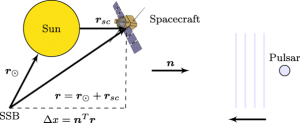
Source: (Chen, 2020)
Until recently, we had to compare the pulsar signal with a relayed signal from a known location in the solar system to extract these measurements. However, more recent research has developed the mathematical framework necessary to enable a spaceship to plot its position in Space fully (and independently). Practically, an initial position can be established with a minimum of four pulsars. A spacecraft might determine its location in Space to within three miles by integrating information from a pulsar’s pulses with a reference point. Pulsar navigation systems have more signals available to them versus traditional satnav.[13] Systems have more resistance to jamming and spoofing due to the wide range of frequencies accessible and the security of signal sources against possible anti-satellite operations (Adamson, 2022).
Conclusions
We started 34,000 years ago and brought you to the present. We covered the operational and technological highlights of each time period. This chapter – and each of the chapters within this book – could be their book. In other words, this is by no means an exhaustive view of the Industry; however, it is a nice view of where the space industry is today and where it is heading. As you navigate the remaining chapters, you will find additional details, concepts, technologies, and use cases. The top technological priorities illustrated in this chapter will be exhibited in varying detail as you progress through each of the readings. Each will provide emergent ideas and innovative perspectives on space systems. Ideas are like spacecraft; they are meant to be launched, get out there and make things happen.
References
Adamson, J. (2022). Use of pulsars for ship navigation: an alternative to the sextant. The Journal of Navigation, pp. 1-20.
Akkaya, I. D. (2016). Systems engineering for industrial cyber–physical systems using aspects. Proceedings of the IEEE, pp. 104(5), 997-1012.
Aniculaesei, A. G. (2018). Toward a holistic software systems engineering approach for dependable autonomous systems. In 2018 IEEE/ACM 1st International Workshop on Software Engineering for AI in AuEngineering for AI in Autonomous Systems (SEFAIAS) IEEE, pp. pp. 23-30.
Barbosa, M. W. (2018). Managing supply chain resources with Big Data Analytics: a systematic review. International Journal of Logistics Research and Applications, pp. 21(3) 177-200.
Berman, A. a. (2016). Technology Feels Like It’s Accelerating – Because It Actually Is. SingularityHub.
Biocca, F. (1992). Virtual reality technology: A tutorial. Journal of communication, pp. 42(4), 23-72.
Chacón, A. A. (2020). Developing cognitive advisor agents for operators in industry 4.0. . New Trends in the Use of Artificial Intelligence for the Industry, pp. 4, 127.
Chen, P. T. (2020). Aspects of pulsar navigation for deep space mission applications. The Journal of the Astronautical Sciences, pp. 67(2), 704-739.
Ermakov, A. I.‐R. (2017). Constraints on Ceres’ internal structure and evolution from its shape and gravity measured by the Dawn spacecraft. Journal of Geophysical Research: Planets, pp. 122(11), 2267-2293.
Erwin, S. (2019). Air Force: SSA is No More; It’s Space Domain Awareness. Retrieved from https://spacenews.com/: https://spacenews.com/air-force-ssa-is-no-more-its-space-domain-awareness
Erwin, S. (2022). Space Domain Awareness: A Secret Weapon Against Shadowy Threats in Orbit. Retrieved from https://spacenews.com/: https://spacenews.com/air-force-ssa-is-no-more-its-space-domain-awareness
Eskins, D. &. (2011). The multiple-asymmetric-utility system model: A framework for modeling cyber-human systems. In 2011 Eighth International Conference on Quantitative Evaluation of SysTems, pp. pp. 233-242 IEEE.
Fiorentino, A. (2022). The First Space Hotel Could Open as Soon as 2025. AFAR: The Future of Travel. Retrieved from https://www.afar.com: https://www.afar.com/magazine/space-hotel-pioneer-station-to-open-in-2025
Fiske, T. a. (2021). Industrial autonomy: How machines will perform their own maintenance. Plant Service. Retrieved from https://www.plantservices.com/: https://www.plantservices.com/articles/2021/automation-zone-industrial-autonomy/
forbes. (2019, June). v2-army-cutaway-1200×741.jpg. Retrieved from https://blogs-images.forbes.com/brucedorminey/files: https://blogs-images.forbes.com/brucedorminey/files/2019/06/v2-army-cutaway-1200×741.jpg
Foundation, N. (2022). Cyber-Human Systems. Computer and Information Science and Engineering (CISE). Retrieved from National Science Foundation: https://www.nsf.gov/cise/iis/chs_pgm13.jsp
Freedberg Jr, S. J. (2014). Hagel Lists Key Technologies for US Military; Launches ‘Offset Strategy. Breaking Defense, p. 16.
Freeth, T., & & Jones, A. (2012). The cosmos in the Antikythera mechanism. Institute for the Study of the Ancient World (ISAW).
Gaffney, V. (2013). Mesolithic timelords: a monumental hunter-gatherer” calendar” at Warren Field, Scotland. Current archaeology, pp. (283), 12-19.
Gheorghiu, D. &. (2013). Place as Material Culture: Objects, Geographies and the Construction of Time. Cambridge: Cambridge Scholars Publishing.
Google Images. (2018, June). Nebra_Scheibe-1024×1007.jpg. Retrieved from https://www.ancient-code.com/: https://www.ancient-code.com/wp-content/uploads/2018/06/Nebra_Scheibe-1024×1007.jpg
Kelvey, J. (2021). 75 Years Ago, A Nazi Rocket Took the First Photo of Earth from Space. Inverse.
Krugh, M. &. (2018). A complementary cyber-human systems framework for industry 4.0 cyber-physical systems. Manufacturing letters, pp. 15, 89-92.
Mao, Z. J. (2020). Physics-informed neural networks for high-speed flows. Computer Methods in Applied Mechanics and Engineering, pp. 360, 112789.
Marchant, J. (2009). Decoding the Heavens: A 2,000-Year-Old Computer–and the Century-Long Search to Discover Its Secrets. NYC: Da Capo Press.
Mittal, S. Z. (2008). Modeling and simulation for systems of systems engineering. Systems of Systems–Innovations for the 21st Century . Wiley.
NASA. (2022). Aurignacian Lunar Calendar. Retrieved from https://i.pinimg.com/: https://i.pinimg.com/originals/c8/40/10/c84010201d8fd16ab2b768383e0af23a.jpg
NASA. (2022). Gemini Capsule Cutaway. Retrieved from https://i.pinimg.com/: https://i.pinimg.com/originals/74/d2/a5/74d2a5a9fe00775c751ac03f105e6aff.jpg
NASA; & Marshack . (2022, Aug 28). oldest lunar calendars. Retrieved from https://sservi.nasa.gov: https://sservi.nasa.gov/articles/oldest-lunar-calendars/
Neufeld, M. J. (2012). The Three Heroes of Spaceflight: The Rise of the Tsiolkovsky-Goddard-Oberth Interpretation and Its Current Validity. Quest: The History of Spaceflight Quarterly.
Nilsson, N. J. (1982). Principles of artificial intelligence. Springer Science & Business Media.
Operations, S. (2022). Space Doctrine Note (SDN) Operations: Doctrine for Space Forces. United States Space Force, Headquarters.
Orozco, J. A., & & Simpson, C. R. (2020). Commercial Crew successes lead the way in a pivotal year. Aerospace America, pp. 58(11), 69-69.
Peregrine, P. N. (2001). Aurignacian. In Encyclopedia of Prehistory. Boston, MA.: Springer.
Pinterest. (1947, Oct 24). First Photo of Earth. Retrieved from https://i.pinimg.com/: https://i.pinimg.com/originals/27/b8/74/27b874a0e9093ef8f2d236e5c4221c4b.jpg
Pritchard, M. (n.d.). Domains, Operations, Technologies. Space Systems: Emerging Technologies and Operations 2022. KSU, Manahattan, KS.
Pritchard, M. (n.d.). Space, From Ideation to Operation. Space Systems: Emerging Technologies & Operations. KSU, Manhattan, KS.
Raissi, M. P. (2019). Physics-informed neural networks: A deep learning framework for solving forward and inverse problems involving nonlinear partial differential equations. Journal of Computational physics, pp. 378, 686-70.
rankred. (2020, July). Far-Side-of-the-Moon-by-Luna-3. Retrieved from https://i1.wp.com/www.rankred.com/: https://i1.wp.com/www.rankred.com/wp-content/uploads/2020/07/Far-Side-of-the-Moon-by-Luna-3.jpg?fit=779%2C600&ssl=1
Roscoe, R. D. (2019). Advancing diversity, inclusion, and social justice through human systems engineering. CRC Press.
Sivolella, D. (2019). Space mining and manufacturing: Off-world resources and revolutionary engineering techniques. Springer Nature.
Soderman, T. (2021). SERVI, The Oldest Lunar Calendars. National Aeronautics and Space Administration. Retrieved from https://sservi.nasa.gov/: https://sservi.nasa.gov/articles/oldest-lunar-calendars/
SpaceX. (2022). SpaceX Falcon Rocket Program. Retrieved from https://i.pinimg.com: https://i.pinimg.com/originals/f2/1a/47/f21a47342bb3ef674720f0bfc722f3df.jpg
Stanley, M. (2022). A New Space Economy on the Edge of Liftoff. Retrieved from https://www.morganstanley.com/: https://www.morganstanley.com/Themes/global-space-economy
Sultan, B. &. (2022). BRICS space diplomacy and response of non-Western countries: the inscription of Neo-Functionalism. Journal of Humanities, Social and Management Sciences (JHSMS), pp. 3(1), 351-365.
Tadjdeh, Y. (2018). Defense Applications Envisioned For Cyber-Human Systems. Robotics and Autonomous Systems. Robotics and Autonomous Systems, National Defense, pp. 102(774), 40-45.
Thomas, V. C., & Makowski, J. M. (2011). The dawn spacecraft. In The Dawn Mission to Minor Planets 4 Vesta and 1 Ceres. NYC: Springer.
Tripp, S. (2021). Self-driving cars only a fraction of projected $1-trillion global autonomous technology market. Boston Business Journal.
United Nations Office for Outer Space Affairs. (2022). Online Index of Objects Launched into Outer Space. United Nations Office for Outer Space Affairs. NYC: United Nations.
Vinogradov, B. V. (1968). Space Photography for the Geographic Study of the Earth (No. NASA-CR-93287). Houston: NASA-CR-93287.
Watson, M. M. (2020). Engineering Elegant Systems: Theory of Systems Engineering. National Aeronautics and Space Administration. Marshall Space Flight Center.
Wikimedia. (2022). 440px-NAMA_Machine_d%27Anticyth%C3%A8re_1.jpg. Retrieved from https://upload.wikimedia.org/: https://upload.wikimedia.org/wikipedia/commons/thumb/6/66/NAMA_Machine_d%27Anticyth%C3%A8re_1.jpg/440px-NAMA_Machine_d%27Anticyth%C3%A8re_1.jpg
Endnotes
[1] An information system need not be a computationally derived device; it can be a book, a carving, or hieroglyphs; any mechanism that allows for information storage is considered an information system.
[2] More commonly known as the V-2 rocket program, it was technically known as Aggregat 4 (A4) program. It was the world’s first guided ballistic missile. It was fueled by a liquid propellent mixture of liquid oxygen and alcohol.
[3] Perigee is the location where an object comes closest to Earth. Apogee is the location where an object is furthest away from Earth. For orbital determinations around generic celestial bodies, we would use pericenter (periapsis, closest) and apocenter (apoapsis, furthest).
[4] The Fédération Aéronautique Internationale (FAI) uses the term Kármán line to define the boundary between aeronautics and astronautics. Aeronautics is aerial activities, including all air sports, within 100 km of Earth’s surface. Astronautics are activities more than 100 km above Earth’s surface. (100 kilometers equals 62.14 miles).
[5] The Mercury 13 were thirteen American women who completed the same physiological screening tests as the astronauts chosen by NASA on April 9, 1959. It was a privately funded initiative loosely affiliated with the Mercury program. Female astronaut candidates were not selected for spaceflight until Astronaut Group 8, for the Space Shuttle program, in 1978
[6] An extrasolar spacecraft is designed to travel beyond our solar system. These spacecraft are typically equipped with advanced power systems and innovative propulsion systems. Voyager 1 and Voyager 2 have left our Solar System. While not originally designed to be extrasolar spacecraft, both have reached interstellar Space.
[7] A minor planet is an astronomical object in direct orbit around the Sun that is exclusively classified as neither a planet nor a comet.
[8] Geocentric refers to spacecraft in Earth’s orbit. Non-Geocentric would refer to all manner of spacecraft in other orbital patterns (e.g., heliocentric (Sun), selenocentric (Moon), areocentric (Mars), etc…).
[9] The Tiangong Space Station (TSS) core module was launched into low earth orbit (LEO) on April 29, 2021.
[10] Extended reality systems (XR) encompass Augmented Reality (AR), Mixed Reality (MR), and Virtual Reality (VR). (Biocca, 1992)
[11] Three dimensions of Space (x,y,z) and one dimension for time (t)
[12] While there are no official standards when it comes to SmallSats (Small Satellites), it is a term used that includes the following: nanosatellites (1-10 kilograms), microsatellites (10 to 100 kilograms), and minisatellites (100 to 500 kilograms). The term also includes CubeSats, the only class of smallsats that are more clearly defined.
[13] A satellite navigation system (satnav) employs satellites to provide geospatial location. Satellite navigation equipment may pinpoint their location (longitude, latitude, and altitude/elevation) with great precision (within a few centimeters to meters).

